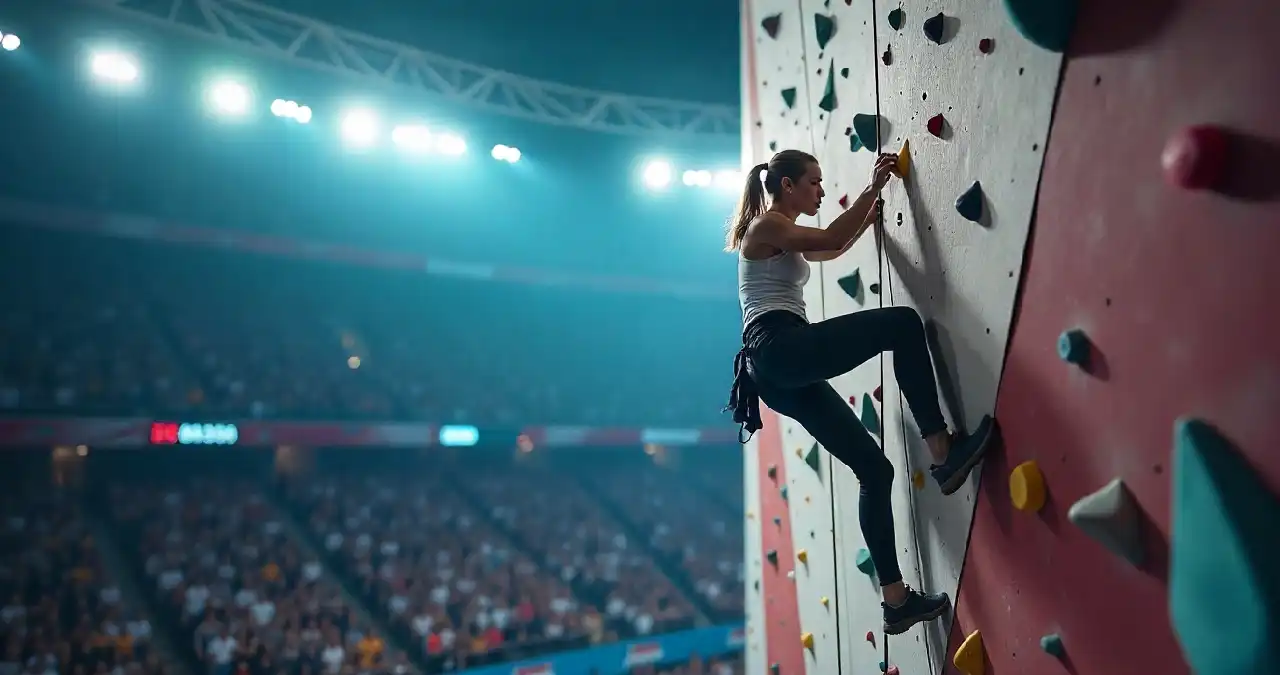Sport climbing is more than just scaling a rock face: it’s a dynamic combination of strength, strategy, and sheer force of will. Unlike traditional climbing, sport climbing uses pre-placed anchors and bolts, focusing on athletics rather than adventure. Think of it as gymnastics on a vertical playground.
History of sport climbing in competitive sports
Sport climbing emerged in the late 20th century when indoor climbing gyms became popular. At first it was a niche activity, but the competitive landscape grew rapidly. International competitions began to gain attention in the 1990s and eventually paved the way for Olympic inclusion.
Sport climbing at the Olympic Games
When did sport climbing become an Olympic sport?
Sport climbing made its Olympic debut in the Tokyo 2020 Games. This inclusion marked a milestone, showing climbing as a serious and globally recognized sport. Although the Olympics were delayed due to the pandemic, the enthusiasm for climbing was undeniable.
Why the Olympic Games chose sport climbing
The Olympic Games wanted a sport that would appeal to a younger audience, combine physicality with strategy and add visual excitement. Sport climbing fits the bill, offering adrenaline-filled moments and displaying incredible athletic ability.
Understand the combined format
What does “combined” mean?
The “combined” format is unique: it merges three different climbing disciplines into a single competition. Athletes must excel in all three: leadership, speed and bouldering. It is a true test of versatility and adaptability, pushing climbers beyond their comfort zones.
The three disciplines: leadership, speed and bouldering
lead climbing
Lead climbing tests endurance. Climbers ascend a high wall on a rope, hooking onto quickdraws along the way. The goal? Reach as high as possible without falling. Think of it as a game of chess with your body, requiring strategy and energy management.
Fast climbing
Fast climbing is pure adrenaline. Two athletes run side by side on identical routes, with the goal of reaching the top faster. Every millisecond counts, so explosive power and impeccable technique are essential. It is the sprint of the climbing world.
bouldering explained
Bouldering is like solving a vertical puzzle. Climbers tackle short, powerful routes called “problems” without ropes. Emphasizes technique, creativity, and problem-solving skills, demanding both physical and mental agility.
Scoring system in the combined format
How athletes are rated in all disciplines
Scoring in the combined format is unique. The athletes’ rankings in each discipline are multiplied to determine their final score. Lower scores are better, as they reward consistent performance in all events rather than mastery in just one.
Multiplicative scoring method
For example, if a climber is second in lead, third in speed, and first in bouldering, his score is 2 × 3 × 1 = 6. The athlete with the lowest total wins. This system challenges climbers to be well-rounded, not just specialists.
Best athletes in sport climbing
Notable male climbers
Names like Adam Ondra and Jacob Schubert They dominate the headlines. These climbers are renowned for their versatility, technical mastery, and ability to handle pressure on the world stage.
Featured climbers
climbers like Janja Garnbret and Ai Mori They have raised the bar for women in sport climbing. Their combination of strength, technique and mental focus makes them formidable competitors in the combined format.
Training for Olympic sport climbing
Physical Preparation and Strength Training
Olympic climbers focus on grip strength, core stability and explosive power. Training often includes fingerboard drills, campus board workouts, and resistance climbing to simulate competition conditions.
Mental preparation and strategy
Mental toughness is equally critical. Climbers must plan every move carefully, stay calm under pressure, and adapt to unforeseen challenges on competition walls. Visualization and mindfulness techniques are common strategies.
Challenges of the combined format
Balancing multiple disciplines
Excelling in all three disciplines is not an easy task. Many climbers have a natural strength in one area, but the combined format forces them to diversify. This balance is the ultimate test of skill and versatility.
Strategies to excel at all events
The best athletes adapt training to cover weaknesses, analyze opponents and develop efficient movement strategies. Recovery, nutrition and injury prevention also play a key role in maintaining peak performance across multiple events.
Material and equipment for sport climbing
Shoes, harnesses and chalk
Climbers depend on specialized equipment for safety and performance. Sticky climbing shoes provide grip, harnesses secure the rope, and chalk keeps hands dry for optimal hold.
Specialized equipment for each discipline
Fast climbing shoes may differ from bouldering shoes due to the need for explosive movements. Lead climbing often requires longer ropes and dynamic drawstrings. Each discipline requires well-thought-out equipment choices.
The 2024 Olympic Games and sport climbing
Highlights from previous Olympic Games
Tokyo 2020 offered exciting moments, with climbers like Janja Garnbret dominating multiple disciplines. Spectators were treated to exciting finishes and surprising surprises, showing the unpredictability of climbing.
What to expect in the next games
The 2024 Olympic Games promise even more excitement, with athletes perfecting strategies and new talent emerging. Fans can anticipate faster climbs, complex rock problems and impressive performances.
The future of sport climbing at the Olympic Games
Possible changes to the format
There is an ongoing debate about separating the disciplines into individual medals rather than a combined score. This change could reward specialists while maintaining broad participation in climbing.
Growing popularity and global reach
Sport climbing is booming worldwide. From youth programs to international competitions, the sport attracts a diverse audience and inspires the next generation of climbers.
Conclusion
Sport climbing at the Olympic Games is a fascinating and adrenaline-filled spectacle. The combined format challenges athletes to master multiple disciplines, combining strength, strategy and mental toughness. Now that the sport is gaining global recognition and evolving rapidly, it’s an exciting time to follow climbing, whether as a hobbyist, aspiring athlete, or simply someone who loves to see humans push their limits vertically.
Frequently asked questions
What is the difference between advance, speed and bouldering?
Leadership focuses on endurance, speed is about sprinting, and bouldering emphasizes problem solving on short walls.
How are scores calculated in the combined format?
The athletes’ classifications in the three disciplines are multiplied and the one with the lowest score wins.
Can climbers specialize in a discipline for the Olympic Games?
Not in the combined format. Competitors must perform well in all three to be successful.
Who are the best climbers to watch in 2024?
Notable names include Janja Garnbret, Adam Ondra and Jakob Schubert.
What equipment is essential for Olympic sport climbing?
Climbers need discipline-specific shoes, harnesses, chalk, and equipment such as quickdraws and specialized climbing walls.










